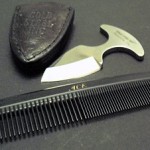 The push knife is touted by some as the most intuitive of edged weapons. This is because, with its T-shaped handle and slim “neck,” the knife puts the blade forward of the knuckles, protruding through the fingers. Any punch with the fist clenched around that knife becomes a potentially lethal thrust with the knife, making simple the transition from pugilism to edged offense.
The push knife is touted by some as the most intuitive of edged weapons. This is because, with its T-shaped handle and slim “neck,” the knife puts the blade forward of the knuckles, protruding through the fingers. Any punch with the fist clenched around that knife becomes a potentially lethal thrust with the knife, making simple the transition from pugilism to edged offense.
Thanks to restrictive weapons laws, the push dagger is not a weapon I would recommend for daily carry. In many localities it will be seen as a “dirk or dagger” and thus restricted. In others it is banned explicitly. Push daggers are, to my understanding, not legal in Canada, for example. You may well encounter the push dagger, however – wielded by those who have less respect for the law than do you. The design of this knife limits what it can and cannot do when used as intended, making it relatively easy to understand. Understanding the push knife makes it easier for you to defend against it. Be warned, however: I can cover only the basics here. I cannot possibly mention every conceivable permutation, nor can I predict or anticipate all of the knife’s applications.
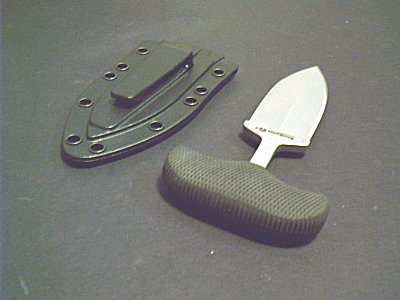
Cold Steel Safekeeper II push knife with Concealex sheath.
Understand, too, that dealing with anyone armed with a knife is an inherently dangerous (and possibly fatal) activity. I do not in any way encourage you to engage in it. The reader assumes any and all risks associated with self-defense in this context.
The push dagger, when gripped as it is designed to be gripped, can do two things. It can thrust forward and it can be used for lateral slashes. Lateral moves generally feel more awkward than do thrusts – and thrusting is what is supposed to make the push dagger so intuitive. When facing a push dagger, it is these knife-punches for which you should be most on guard.
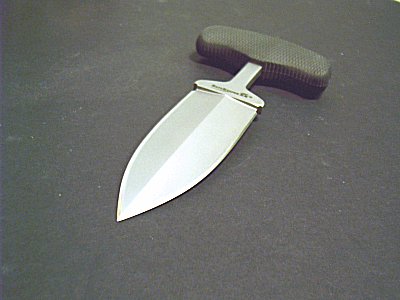
Push daggers vary, but they all conform to this general T-shape.
The two basic thrusts you’ll encounter are a standard straight punch with the knife and a an upper-cut style shove that might come in straight or might be canted upward. The blade might be held vertically or might be held horizontally, depending on the type of punch used. In the pictures blow, the straight punch looks like a vertical (sun fist) strike. The upper-cut style thrust is canted to come in under the rib cage into the gut. Any possible variation on these angles could be used, at any “altitude” on the body. The upper-cut thrust can be delivered with savage power and is particularly dangerous because it can come in below the level of your vision.
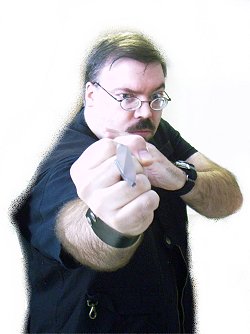
Straight thrust with the push knife.
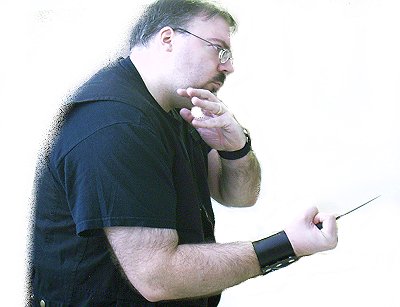
Upper-cut thrust up and into the belly below the rib cage.
Slashes with the push dagger can be straight (including diagonal, but straight in relationship to the lateral movement of the arm) or they might be canted, with the blade held at an angle and moved through the same horizontal arc. A knife slash is a knife slash, really; what you’re hoping for will be an opening to trap the elbow or shoulder of the knife arm. In the completed canted slash in the figure below (left), the trap to the shoulder and elbow should be obvious. The picture shows the slash almost completed.
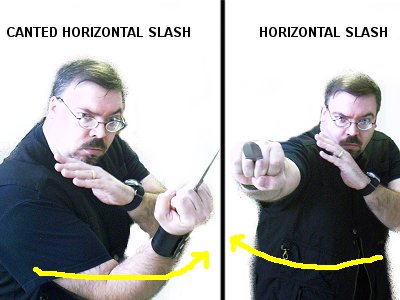
Slashing with the push knife. Canted (left) and simple horizontal (right).
Two of the more common and traditional locations for carry of a push knife are the waistband (in front, behind the hip, or at the small of the back) and the boot. Boot carry is generally quite awkward for all but back-up carry (or for drawing when seated). Waistband carry, by contrast, can be adapted for a variety of body types and clothing. If you’re a large man like me, you find carry behind the hip to be most comfortable. Some advocate small-of-back carry, but it’s best to avoid any carry method that puts a piece of metal directly over your spine.
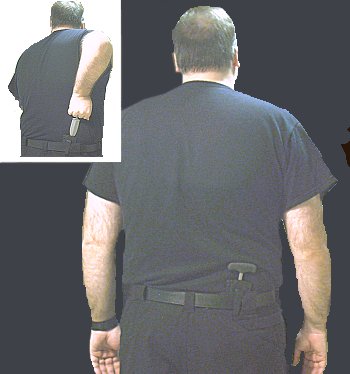
Carrying the push knife behind the hip (not over the spine).
Some knives may be carried clipped inverted inside an outer piece of clothing like a vest. Keep an eye out for movements that are precursors to a draw, including going for something inside an outer shirt (very obvious), dropping to access boot carry, or distracting hand movements and verbalization that mask what the other hand is doing.
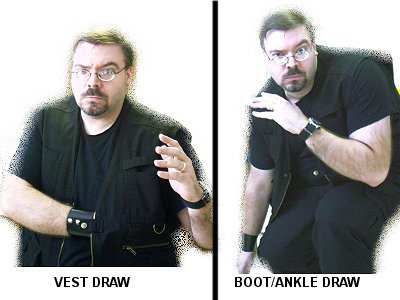
Going for something inside a shirt or vest (left) is pretty obvious, as is
dropping to access a knife carried in a boot or around the ankle.
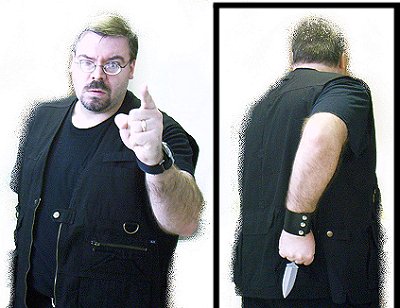
When someone gets aggressive or starts waving one hand around,
you had better start looking for the other limb. Where is it?
A precursor to drawing from behind the hip could be a clothing sweep, often in conjunction with raising the guard hand to cover the draw. If you’re thinking of charging the guard hand when you see this, reconsider. Controlling that extended limb will do you no good if he’s stabbing you with his other hand.
There is little you can do to counter savage, reciprocating thrusts except not to be there. You can try to get off the line of the attack, you can try to arch your body and then perhaps backpedal to put you out of range, and you can try to slap down at the incoming limb. None of these options is particularly attractive (and this is why facing someone intent on killing you with a knife is not something you want to do).
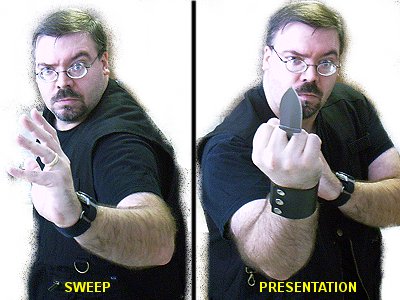
This is a quick swivel of the body in which the drawing hand goes
behind the body as the guard hand comes forward. The weapon
hand then comes forward as the guard hand comes back.
While slashes are nothing you wish to suffer if you can help it, a much greater risk of death is presented by thrusts into the body. A thrust into your vital organs can kill you. A slash can kill you as well, of course, but unless you are hit in an artery, a thrust represents more immediate danger. As such, the push knife is a weapon designed to kill you.
Respect it and understand it to better defend against it.
Ok question i prefer blades over guns so i carry a blade the push dagger is very beneficial for me because boxing is and always has been my discipline i am also a right hander boxing wise that would be my power hand left hand is my jab hand uppercuts hooks as welp so what side would be better to carry on the left or right thank you for your time and reply
I can’t imagine it would matter.
I’m 70 years old. I can still handle myself, I feel of the danger of the young and unfortunate of their thinking sometimes we can not be intimidated so let me inquire about your product. Thank you.